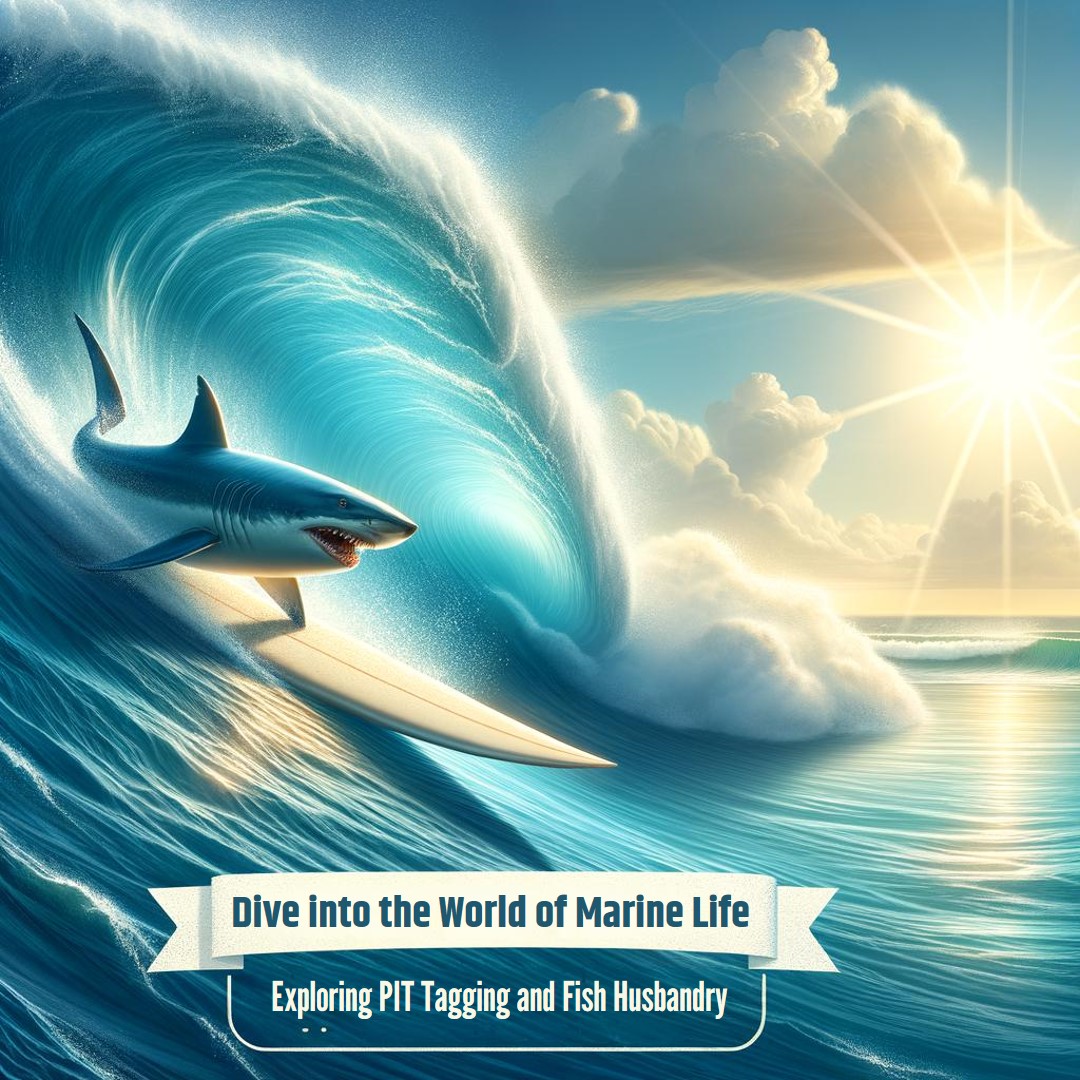In the realm of fish husbandry and marine life research, tracking individual animals is crucial for understanding behaviors, migration patterns, population dynamics, and overall ecosystem health. One of the most effective tools for this purpose is the Passive Integrated Transponder (PIT) tag. These small, implantable devices provide researchers with a reliable way to monitor and collect data on marine life. This article delves into the benefits, applications, and future innovations of PIT tag, emphasizing their significance in fish husbandry and marine life research.
What are Passive Integrated Transponders(PIT) Tags?
Passive Integrated Transponders(PIT) tags are small, biocompatible devices that can be implanted into animals. Each tag contains a unique identification code that can be read by a scanner. These tags are passive, meaning they do not require a power source; instead, they are activated by the electromagnetic field of the scanner. This feature allows (PIT) tags to last for many years, making them ideal for long-term studies.
Benefits of Passive Integrated Transponders(PIT) Tags
1. Longevity and Durability
(PIT) tags are designed to last for the lifetime of the tagged animal. Unlike other tracking devices that require batteries, PIT tag do not lose functionality over time. This makes them particularly valuable in long-term studies where the goal is to monitor individual animals over several years.
2. Minimal Impact on Animals
Due to their small size and biocompatible materials, (PIT) tags cause minimal stress and physical impact on the animals. The tagging process is relatively quick and can be performed without the need for anesthesia in many cases, further reducing the stress on the animal.
3. High Data Accuracy
(PIT) tags provide highly accurate data, which is essential for scientific research. Each tag emits a unique code, ensuring that there is no confusion between different individuals. This level of precision is crucial for studies involving population dynamics and individual behavior.
4. Cost-Effective
While the initial cost of PIT tagging equipment can be high, the long-term benefits often outweigh these costs. The durability and longevity of the tags mean that they do not need to be replaced frequently, reducing ongoing expenses.
Applications of Passive Integrated Transponders(PIT) Tags in Fish Husbandry and Marine Life Research
1. Population Monitoring
(PIT) tags are extensively used to monitor fish populations. By tagging a sample of the population, researchers can gather data on survival rates, growth, and migration patterns. This information is vital for managing fish stocks and ensuring sustainable practices in fish husbandry.
2. Behavioral Studies
Understanding the behavior of marine animals is essential for conservation efforts. PIT tag allow researchers to track individual movements and interactions within a population. This data can reveal important insights into mating habits, territorial behaviors, and social structures.
3. Migration Tracking
Many marine species undertake long migrations. Passive Integrated Transponders(PIT) tag enable researchers to track these movements accurately. For example, salmon are often tagged to study their migration from rivers to the ocean and back. This information is crucial for designing conservation strategies and managing fisheries.
4. Health and Disease Monitoring
In fish husbandry, keeping track of the health and disease status of the population is critical. PIT tag can be used to monitor individual fish in aquaculture settings, allowing for early detection of disease outbreaks and better management of health interventions.
Voda IQ’s Role in Enhancing PIT Tagging Technology
Voda IQ is at the forefront of developing advanced PIT tagging solutions tailored to the needs of fish husbandry and marine life research. By providing high-quality tags and state-of-the-art scanning equipment, they helps researchers and fish farmers gather accurate and reliable data. The integration of Voda IQ’s technology into research and husbandry practices ensures that data collection is efficient and minimally invasive to the animals.
Future Innovations in PIT Tagging
1. Integration with Other Technologies
The future of PIT tagging lies in the integration with other tracking and monitoring technologies. Combining PIT tag with satellite tracking and environmental sensors can provide a more comprehensive understanding of marine ecosystems. This multi-faceted approach allows researchers to correlate individual animal data with environmental changes, leading to more robust conservation strategies.
2. Smaller and More Advanced Tags
Advancements in microelectronics are paving the way for even smaller and more sophisticated PIT tag. These new tags could include additional sensors to monitor physiological parameters such as heart rate and body temperature. This development would provide an even deeper understanding of animal health and behavior.
3. Automated Data Collection and Analysis
The automation of data collection and analysis is another exciting innovation in PIT tagging technology. Automated scanning stations can be deployed in strategic locations, such as fish ladders and spawning grounds, to continuously monitor tagged animals. The data collected can be instantly transmitted and analyzed using AI algorithms, providing real-time insights into population dynamics and behavior.
4. Ethical and Sustainable Practices
As the field of marine research continues to grow, there is an increasing focus on ethical and sustainable practices. Future PIT tagging technologies will likely prioritize animal welfare, ensuring that tagging procedures are as non-invasive as possible. Additionally, sustainable materials and production methods will become more prevalent, aligning with the broader goals of environmental conservation.
FAQs about Passive Integrated Transponders(PIT) Tags
1. What are the primary uses of (PIT) tags in marine research?
(PIT) tags are primarily used for tracking and monitoring individual animals. They are invaluable for studying population dynamics, migration patterns, and individual behaviors. In fish husbandry, they help monitor health and growth rates.
2. How long do PIT tag last?
PIT tag are designed to last for the lifetime of the animal. They are passive devices without batteries, which means they do not have a limited lifespan and can function for many years.
3. Are (PIT) tags harmful to the animals?
No, (PIT) tags are designed to be biocompatible and cause minimal stress to the animals. The tagging process is quick, and the tags are small enough to be implanted without causing significant harm.
4. How do researchers read the data from (PIT) tags?
Researchers use scanners that emit an electromagnetic field to read the unique code of each PIT tag. These scanners can be handheld or installed at strategic locations, such as fish passages or spawning grounds.
5. Can (PIT) tags be used in conjunction with other tracking technologies?
Yes, (PIT) tags can be integrated with other tracking technologies like satellite tags and environmental sensors. This integration provides a more comprehensive understanding of marine ecosystems and animal behaviors.
Conclusion
Passive Integrated Transponders(PIT) tags are a cornerstone of fish husbandry and marine life research, offering reliable and long-term tracking capabilities. The benefits of these tags, including their longevity, minimal impact on animals, high data accuracy, and cost-effectiveness, make them indispensable tools for researchers and fish farmers alike. As technology advances, the potential for PIT tag to provide even more detailed and comprehensive data will continue to grow, enhancing our understanding of marine ecosystems and aiding in their conservation.
As we look to the future, innovations in PIT tagging technology promise to bring even greater insights and advancements. From integrating with other tracking systems to developing smaller and more advanced tags, the possibilities are vast and exciting. How will these innovations shape the future of marine life research and conservation?
Also know about



